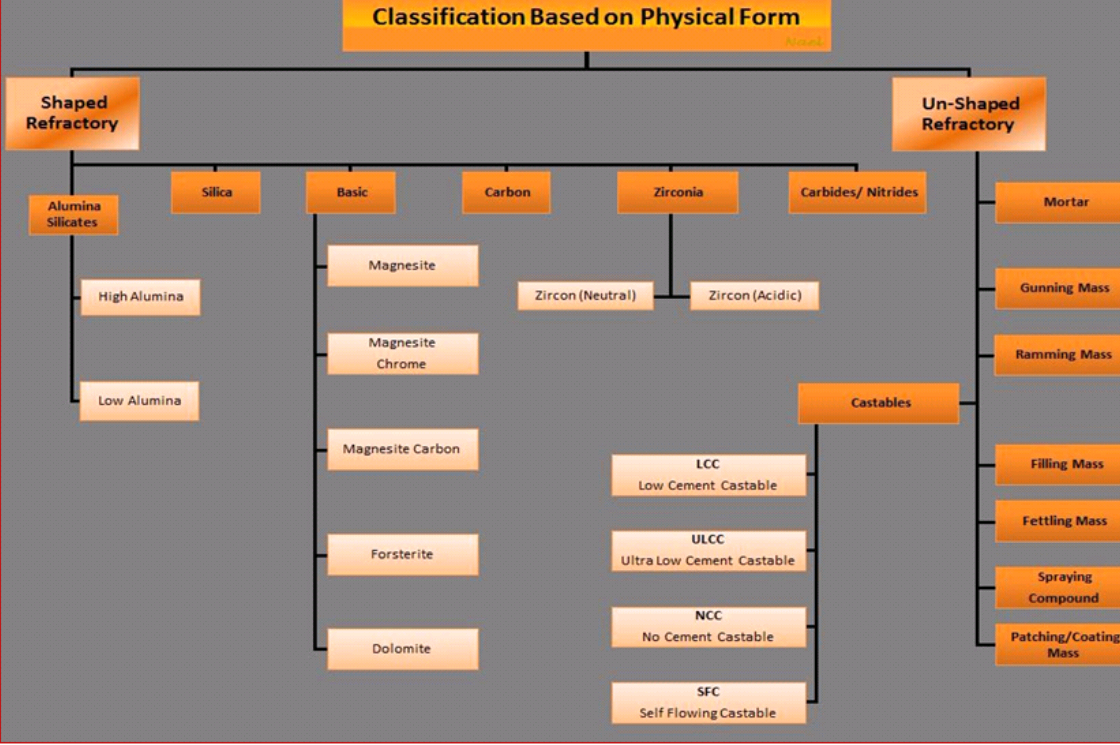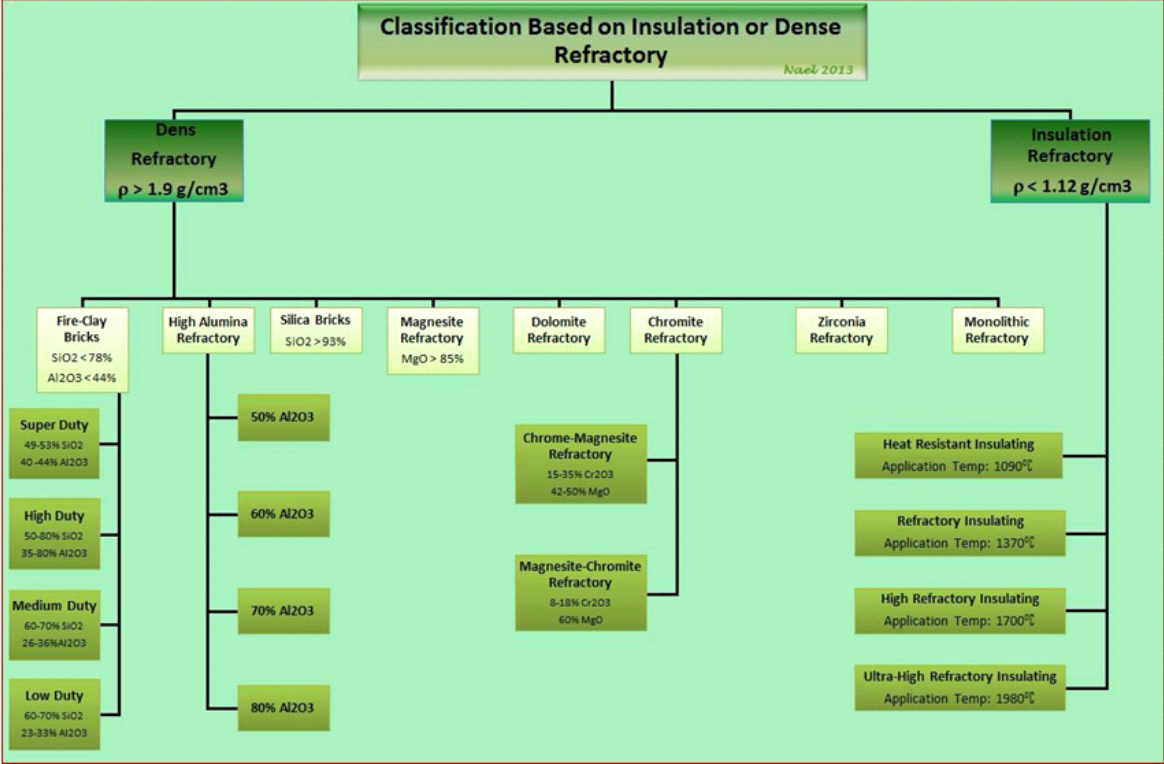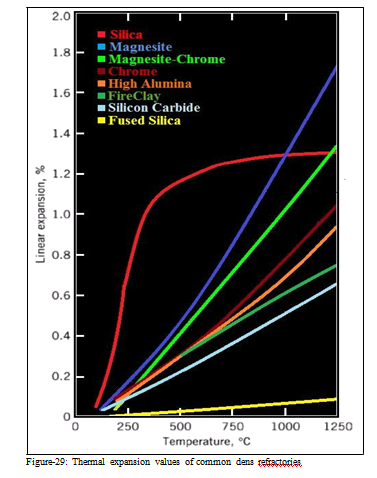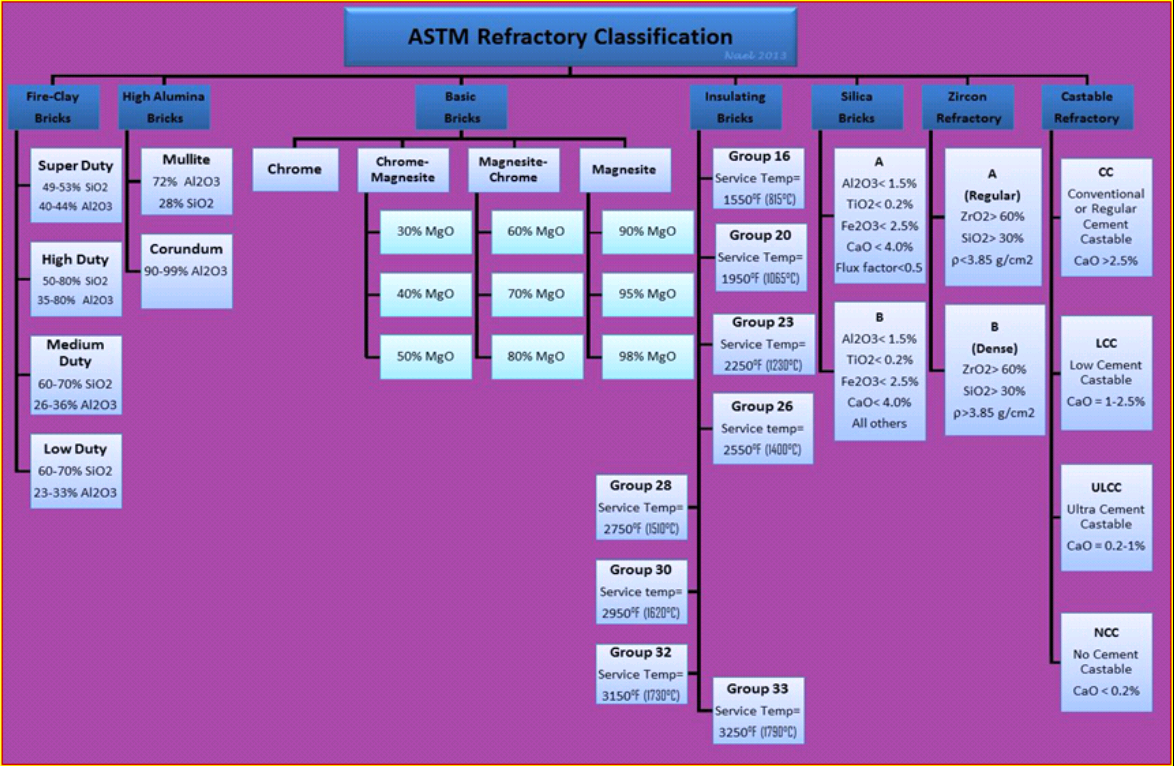Contents
click here to Download the Most Important 13 Books in Cement Industry
click here to Download the Most Important 13 Books in Cement Industry
What is the basis need to be followed in refractories Classification?
By: Nael Shabana qatar.cement@yahoo.com
: Refractories can be classified on the basis of chemical composition form, physical form, dense or insulating form, or methods of manufacture form.
a). Classification Based on Refractories Chemical Composition: Refractories are typically classified on the basis of their chemical behavior. Accordingly the refractory materials are of three classes
- Acid Refractories: are those which are attacked by alkalis (basic slags). These are used in areas where slag and atmosphere are acidic. Silica refractories (greater than 92% SiO2) and siliceous refractories (78% to 92% SiO2) are examples of acid refractories.
- Basic Refractories: are those which are attacked by acid slags but stable to alkaline slags, dusts and fumes at elevated temperatures. Magnesia (MgO) is a very common example. Other examples include dolomite and chrome- magnesia. 3 . Neutral Refractories: are chemically stable to both acids and bases and are used in areas where slag and atmosphere are either acidic or basic. The common examples of these materials are Carbon graphite (most inert),chromites (Cr O ), and alumina.
b). Classification Based on Refractory Physical Form: These are the shaped and unshaped refractories. The former is commonly known as refractory bricks and the latter as “monolithic” refractories (figure-25).
- Shaped Refractories: are those which have fixed shaped when delivered to the user. These are what we call bricks. Brick shapes divided into two groups; standard Shape and special Shape.
- Unshaped Refractories: are without definite form and are only given shape upon application. It forms joint less lining and are better known as monolithic refractories. These are categorized as Plastic refractories, ramming mixes, castables, gunning mixes, fettling mixes and mortars.
- Castable Refractories: These are the materials that contain cement binder usually aluminate cement, which imparts hydraulic setting properties when mixed with water.
- Coating Refractories: This type of product is used to protect refractory linings usually against chemical attack.
- Mortars: Are generally neither classified under refractory brick nor monolithic refractories. These are finely ground refractory materials, which become plastic when mixed with water.
- Gunning Mixes: Are granular refractory materials sprayed on application area, used for patching and maintenance works for kilns and furnace.

Figure-25: Physical Form Refractory Classification
c). Classification Based on Insulating or Dense Form:
- Insulating Refractories: have lower densities and provide insulating properties, while offering resistance to corrosion and chemical reactions with the operating environment. Generally; refractory thermal conductivity depends on the chemical and mineral composition of the material and increases with decreasing porosity. Figure-26 shows the thermal conductivities of some common refractories.
In most cases, glass (silica), mineral wool, high alumina, mulite, or zirconia are the base materials and can be used to temperatures as high as 1593°C. This class of materials has a lower density that varies from 0.064 to 0.19 g/cm3 offers
higher thermal resistance compared to firebricks. In all cases, thermal conductivity of the insulation increases significantly as temperature increases. Insulating materials can be classified with respect to application temperature as showing below:
- Heat resistant insulating materials for application temperatures up to 1090°C as calcium silicate materials and alumino-silicate fibers.
- Refractory insulating materials for application temperatures up to 1370°C as lightweight chamotte, kaolin bricks, mixed fibers and aluminum oxide fibers.
- High refractory insulating materials for application temperatures up to
1700°C as lightweight mullite and alumina bricks, lightweight hollow sphere corundum castables and bricks, and special high refractory fibers.
- Ultra-high refractory insulating materials for application temperatures up to 1980°C as zirconia lightweight bricks and fibers.
- Dense Refractories: Refractories with a density higher than 1.9 g/cm3. They offer excellent resistance in challenging operating environments, such as slags with different chemical compositions, fumes, dust, and gases. Dense refractories classified to several groups as below:
- Fire-clay brick Refractories: Fire-clay bricks comprise about 75% of the production of refractories on a volume basis and are essentially hydrated aluminum silicates. They subdivided into four major classifications (figure-27) depending primarily upon fusion temperature.

- High Alumina Refractories: Alumina is one of the most chemically stable oxides known, which offers excellent hardness, strength and spalling resistance. The refractoriness of high alumina refractories increases with increase of alumina percentage.
- Silica Refractories: Silica brick is a refractory material containing at least 93% SiO2. From a volume standpoint silica brick are second only to fire clay brick. The outstanding property of silica brick is its excellent mechanical strength at temperatures approaching their actual fusion point.
- Magnesite: Magnesite refractories are chemically basic materials, containing at least 85% magnesium oxide. These are made from naturally occurring magnesite (MgCO3) and Silica (SiO2). The physical properties of this class of brick are generally poor, and their great value is primarily in their resistance to basic slags.
- Dolomite: The natural double carbonate dolomite (CaCO – MgCO ) can
3 3
be converted to refractory dolomite (CaO- MgO) by high temperature
firing. Dolomite refractories is found to be the most compatible material with the cement kiln clinker as it provides excellent coating stability, has very good resistance to thermal shock & alkali attack in varying kiln operating conditions.
- Chromite Refractories: A distinction must be made between chrome- magnesite refractories and magnesite-chrome refractories.
Chrome-magnesite refractories: Usually contains 15-35% Cr2O3 & 42- 50% MgO. These materials can withstand corrosive slags and gasses and have high refractoriness.
Magnesite-chromite refractories: Magnesite-chromite refractories contain at least 60% MgO and 8-18% Cr2O3. Magnesite-chromite usually has a better spalling resistance than chrome-magnesite.
- Zirconia Refractories: Zirconium dioxide (ZrO2) is a polymorphic material. There are certain difficulties in its usage and fabrication as a refractory material.
- Monolithic Refractories: This name generally given to all unshaped refractory products. Castable and gunning materials are common monolithic refractories.
The figure below (figure-28) is showing refractories classification based on insulation which has a density less than 1.12 g/cm3 or dense which has a density more than 1.9 b/cm3.

Dense refractories, like most other solids, expand upon heating, but much less than most metals. The degree of refractories expansion depends mainly on the chemical composition. A diagram of the thermal expansion of the most common refractories is shown in figure-29.

d). Classification Based on Method of Manufacture: The refractories can be manufactured in either of these methods: Dry Press Process, Fused Cast, Hand Molded, Formed (Normal, Fired or chemical bonded), and Unformed (Monolithic – Plastics, Ramming mass, Gunning, Cast able, Spraying).
e). ASTM Classification: ASTM also publishes a list of classifications covering a wide variety of refractory types (figure-30). According to ASTM; refractories are classified to:
- Fireclay & High Alumina Brick: High alumina bricks are classified according to alumina content, starting at 50% and continuing up to 99% Al2O3.
- Basic Brick: Chrome brick, chrome–magnesite brick, magnesite–chrome brick, and magnesite brick. There are six classes of chrome–magnesite and magnesite–chrome brick starting with 30% MgO and increasing in 10% increments to 80% MgO.
- Insulating Brick: Insulating firebricks are classified by groups as shown in figure-30 corresponds to the service temperature divided by 100. For example, group 16 corresponds to a test temperature of 1600◦F (871◦C).
- Mullite Refractories: This brick must have Al2O3 content between 56 and 79% and contain less than 5% impurities.
- Silica Brick: Silica bricks are classified in two types. Types A and B silica bricks are classified according to chemical composition and strength. Type A brick must have a flux factor ≤ 0.5. The flux factor is equal to the percent alumina plus twice the percent of alkalis. Type B is all other silica brick covered by the standard chemical and strength specifications.
- Zircon Refractories: Zircon refractories are classified in two types. Types A and B have the same chemical requirements of not less than 60% ZrO2 and not less than 30% SiO2.
- Castable Refractories: Hydraulic-setting refractory castables are classified into five classifications:
a). Conventional or Regular Castable (CC): Conventional castable class contains hydraulic setting cement and has total calcium oxide content greater than 2.5%. This class is subdivided into a normal strength and high strength class.
b). Low Cement Castable (LCC): Low cement castable is classified on the basis of calcium oxide with a value of 1-2.5 %.
c). Ultra-Low Cement Castable (ULCC): Ultra low cement castable is classified
on the basis of calcium oxide with a value of 0.2-1.0 %.
d). No-Cement Castable (NCC): No-cement castable is classified on the basis of calcium oxide with maximum value of 0.2 %.
e). Insulating Castable Refractories: The lime content is not a result of a hydraulic setting cement constituent but comes from aggregate impurities.

Figure-30: ASTM refractory classification
Such a great and wonderful information and I really appreciate that you shared this wonderful content.